The document discusses the design and implementation of an improved LZW data compression algorithm utilizing a dictionary based on content addressable memory. The proposed method achieves a reduction in storage space by 60.25% and increases the compression rate by 30.3%, utilizing a 5-bit code instead of the standard 7-bit ASCII representation. The results, obtained using Xilinx tools, demonstrate the effectiveness of the finite state machine approach in enhancing the algorithm's performance.

![International Journal of Information Sciences and Techniques (IJIST) Vol.2, No.4, July 2012
72
dictionary with all possible symbols that can occur. LZW compression replaces string of
characters with codes. LZW algorithm is a lossless data compression algorithm which is based on
dictionaries [1]. This LZW compressor maintains records with characters that have been read
from a file to be compressed. Each character is represented by an index number in the dictionary.
In this paper, we proposed a improve scheme for data compression. By utilizing, content access
memory dictionaries are built in the proposed system. Each character in dictionary is replaced
with a code which is less number of bits than its ASCII code. The proposed LZW algorithm is
evaluated by finite state machine technique in VHDL. This paper is organized as follow in section
2 an introduction to LZW algorithm is explained; in section 3, LZW data compression algorithm
using finite state machine (FSM) is described. In section 4 experiments and results are shown.
Finally conclusion is exposed in section 5.
1.1. Data Compression Model
The block diagram of data compression model is described in figure 1.
Input data
Reduction
Reduction of entropy
Entropy encoding Compressed Data
Figure 1: Data compression model
A data compression model consists of three major stages which are redundancy, reduction in
entropy and entropy encoding.
2. Data Compression Algorithm: LZW (Lempel-Ziv Welch) Algorithm
There are many algorithms which have been used for data compression like Huffman and Lempel-
Ziv-Welch (LZW), arithmetic coding.LZW algorithm is the most popular algorithm. LZW
algorithm is just like a greedy approach and divides text into substrings. Like the LZW algorithm
proposed in [2]. LZW algorithm has both compression and decompression techniques which is
explained as below.
2.1.LZW Compression Algorithm
LZW compression algorithm is dictionary based algorithm which always output a code for a
character. Each character has a code and index number in dictionary. Input data which we want to](https://image.slidesharecdn.com/2412ijist07-240321072637-7e60acbc/75/Design-and-Implementation-of-LZW-Data-Compression-Algorithm-2-2048.jpg)
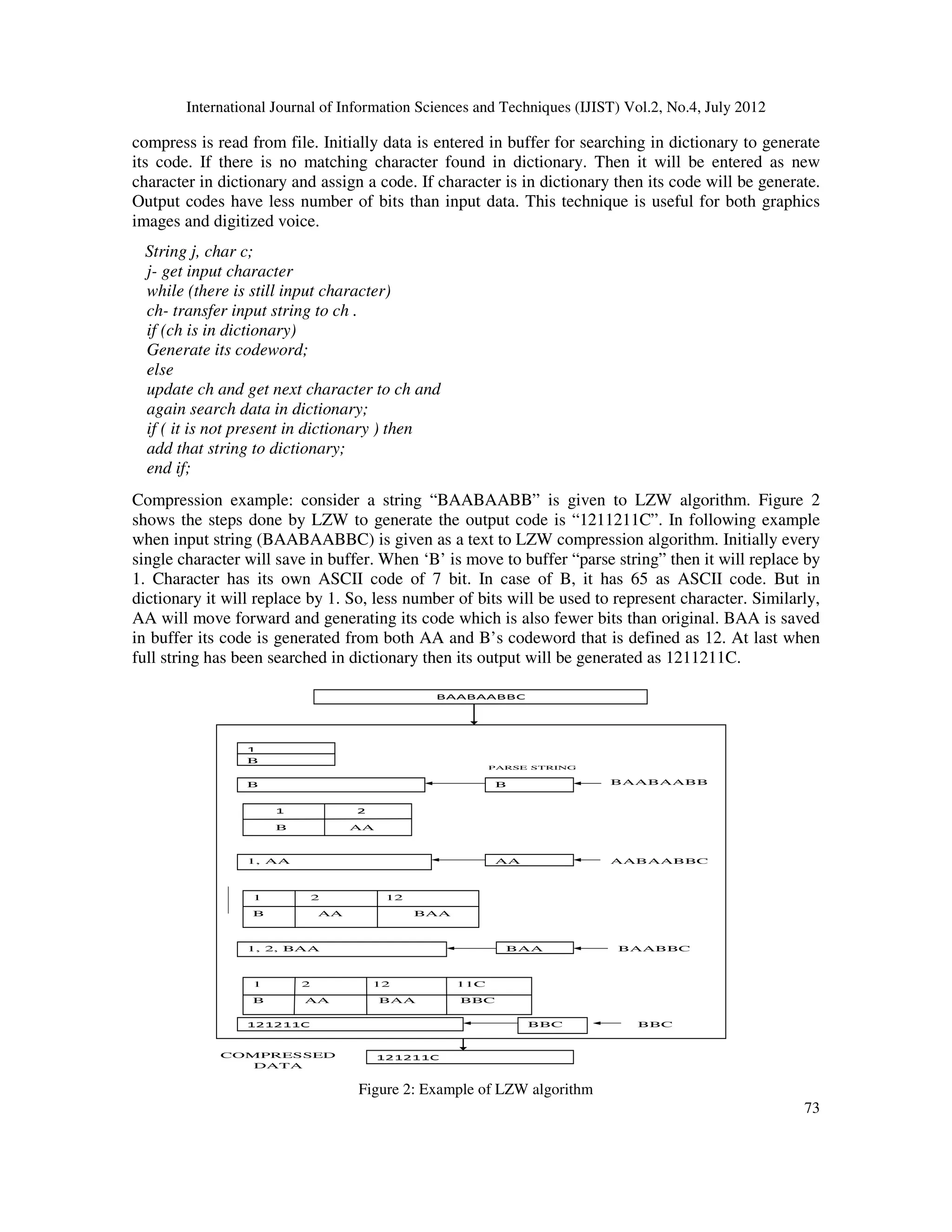
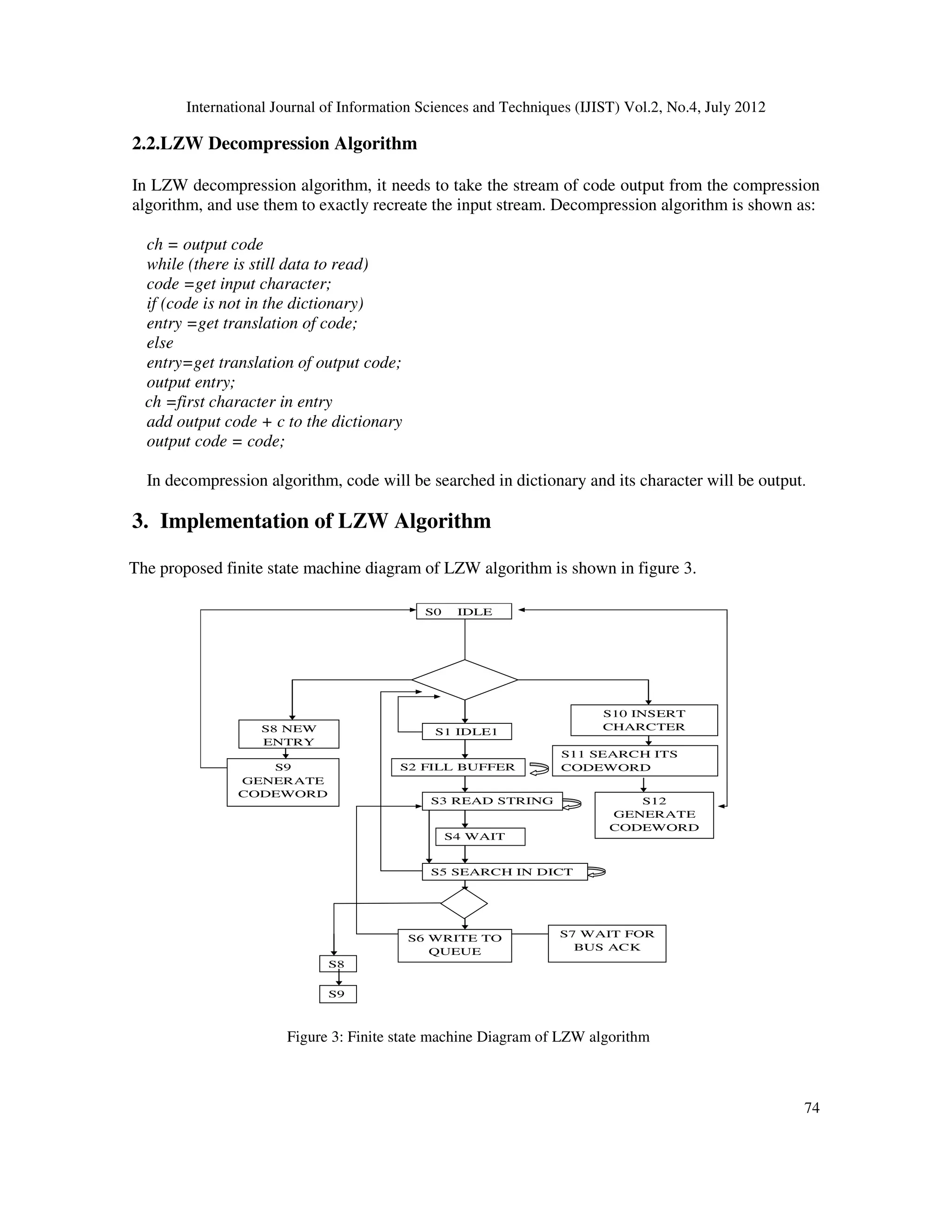

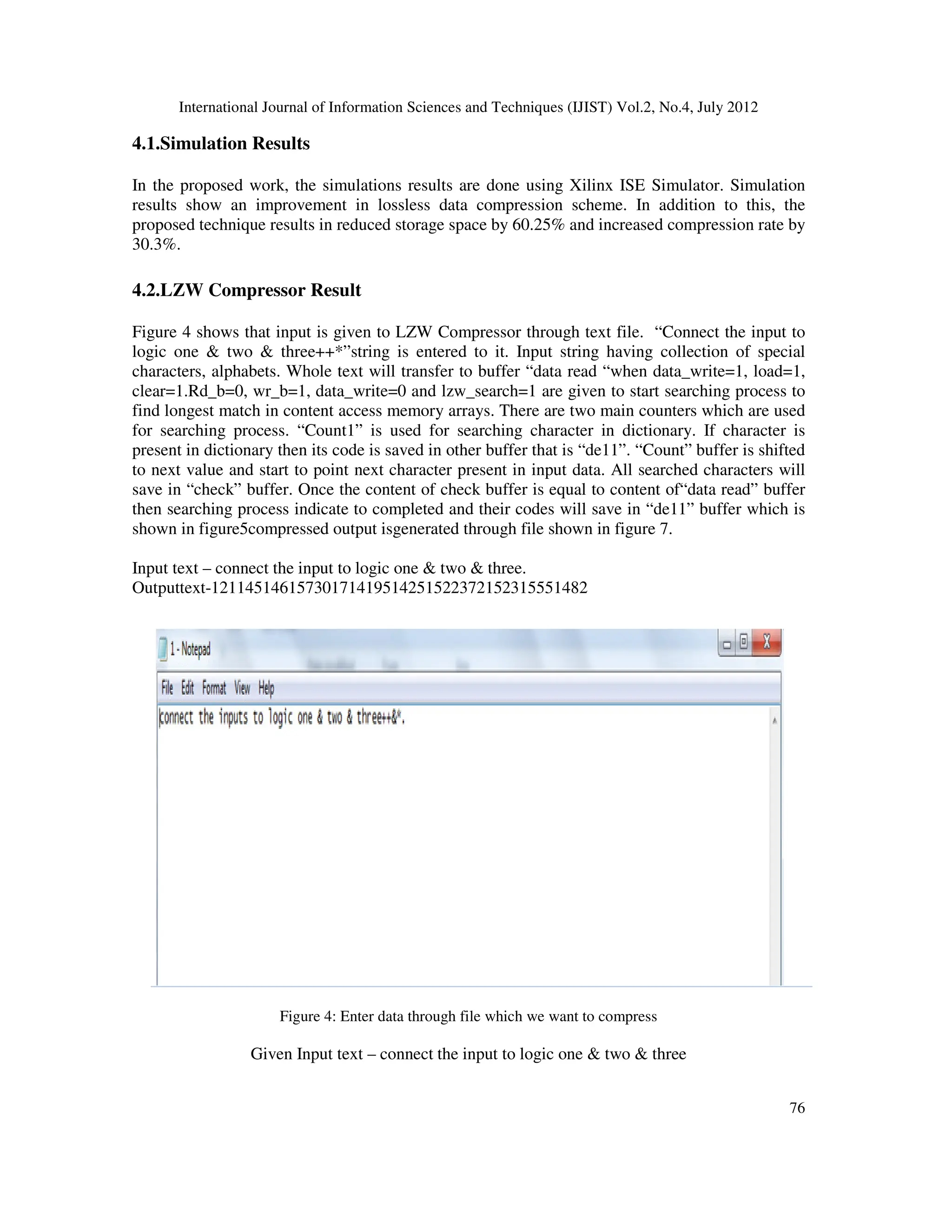
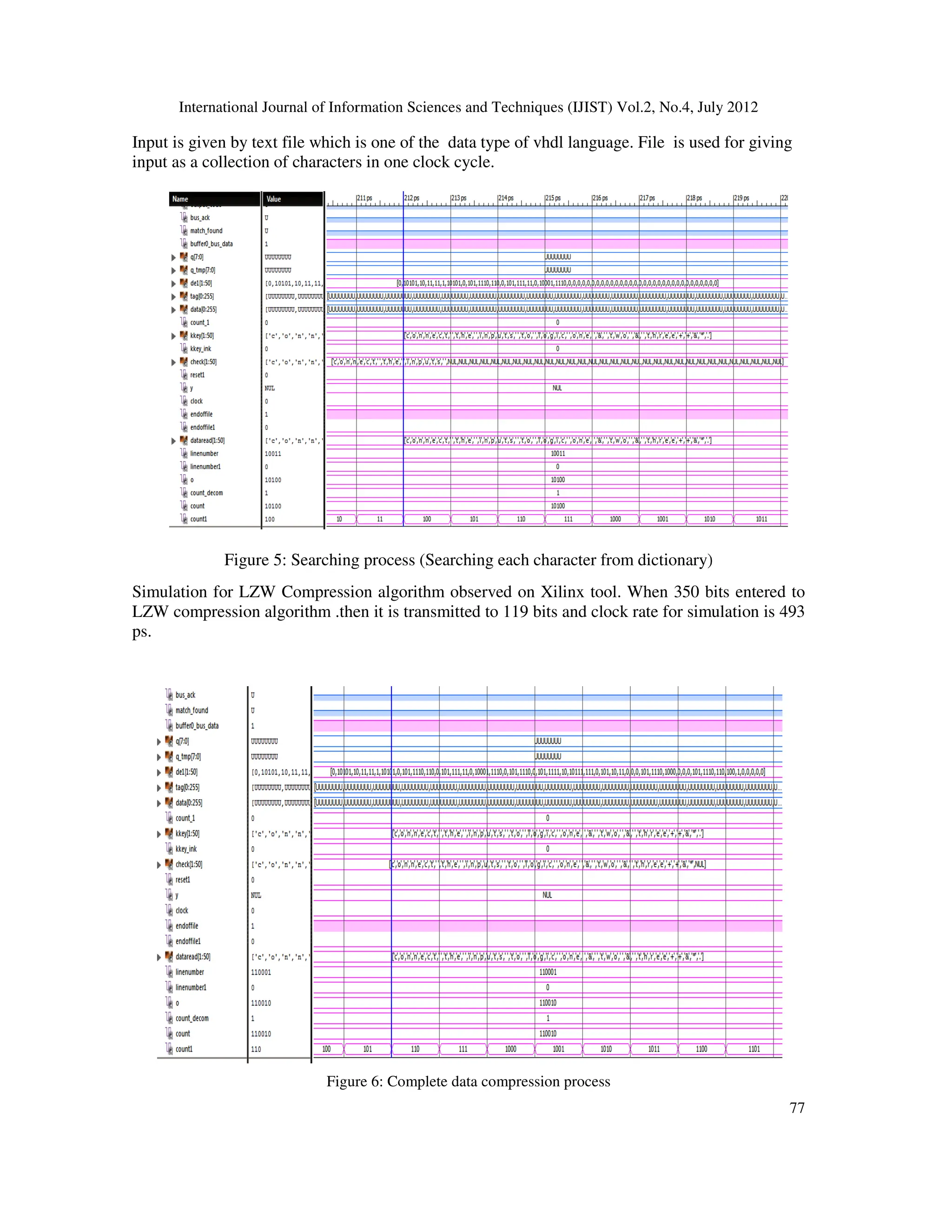
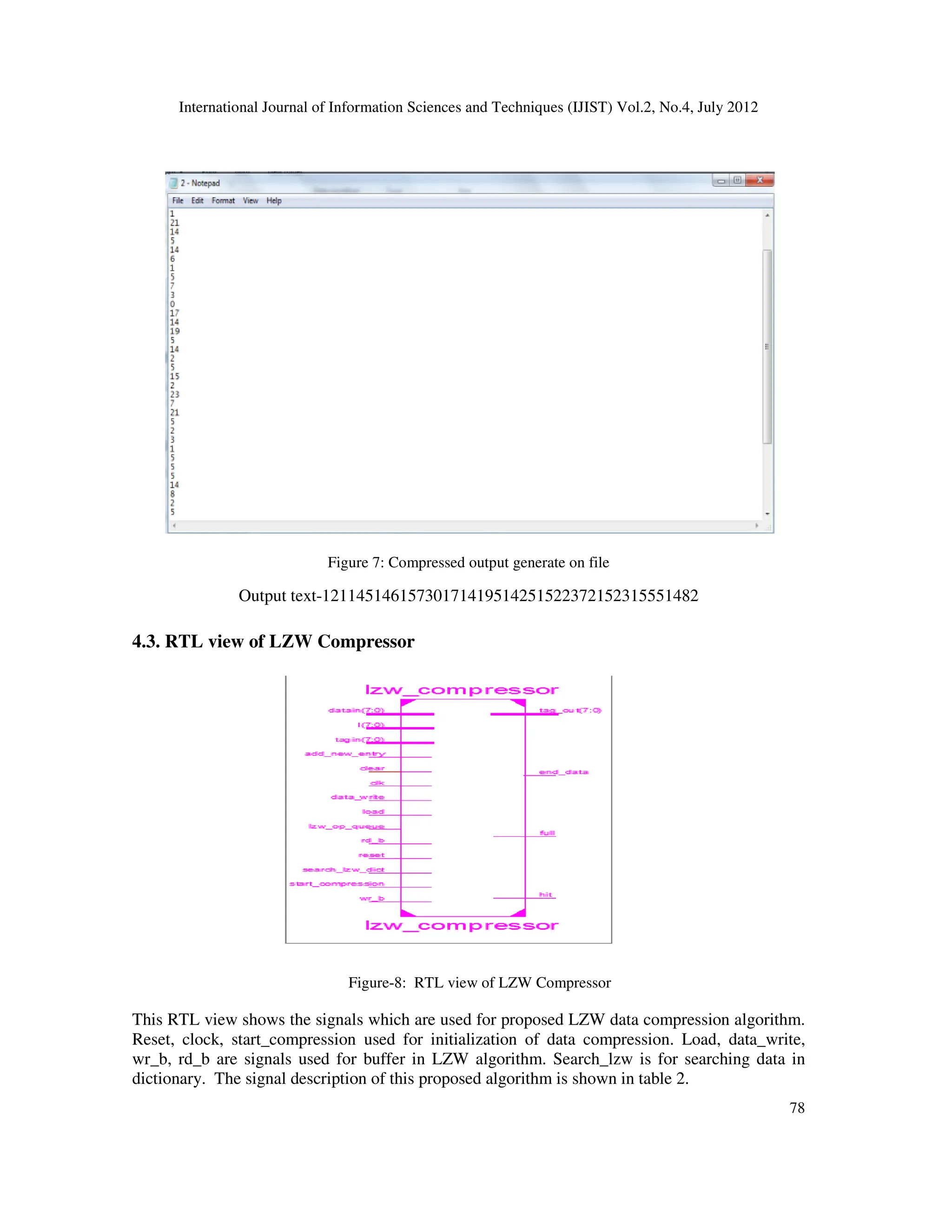
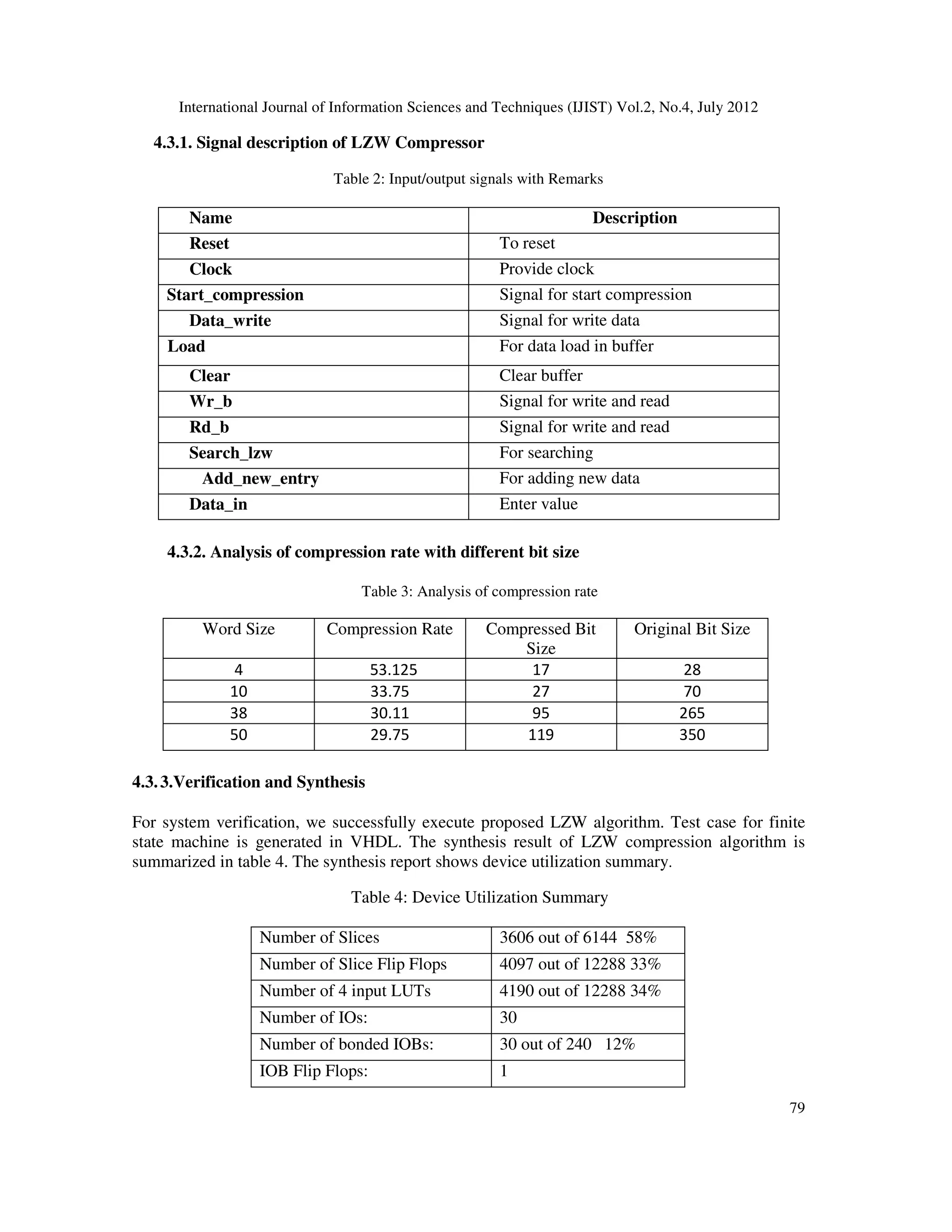
![International Journal of Information Sciences and Techniques (IJIST) Vol.2, No.4, July 2012
80
4.4.Comparison of the Results with the Previous Work
The results achieved are compared with the reference work is shown in table 5. It is concluded
that enhancement in the performance of LZW Data Compression algorithm by using less number
of bits than their ASCII code, utilizing content addressable memory arrays. Thus the text data can
be effectively compressed and compared with previous work. In addition to this, the proposed
research work, results show the reduction in storage space by 60.25% and increase the
compression rate by 30.3%. Comparison of this work with previous work is described in table 5
shown as:
Table 5: Comparison between this research works with previous work
Input Size Compressed bit with previous work Compressed bit with
Improved LZW
112 104 70
144 96 90
152 100 95
184 156 115
360 296 225
5. Conclusions
In order to get better compression rate, the proposed dictionary based LZW algorithm can
replace their codes with 5 bits instead of 7 bits ASCII code. LZW algorithm is evaluated by
finite state machine technique. With this technique we have observed that storage space is
reduced up to 60.25% and compression rate improved up to 30.3%.Weanalyze compression rate
with different number of input bits on Xilinx tool.
6. References
[1] Parvinder Singh,ManojDuhan and Priyanka(2006)“Enhancing LZW Algorithm to Increase Overall
Performance”, Annual IEEE Indian Conference,pp1-4.
[2] Ming-Bo Lin, Jang-Feng Lee, G. E. Jan,( 2006)“ALossless Data Compression and Decompression
Algorithm and Its Hardware Architecture” VLSI IEEE Transactions ,Vol.14,pp925-936.
[3] YiCao, Guoging Wu, Huawei Wang,( 2011) “A Smart Compression Scheme for GPU-Accelerated
Volume Rendering of Time-Varying Data.” Virtual Reality and Visualization (ICVRV)
conference.pp205-210
[4] Guolv.Tan, Yujun Wang,( 2009) “A Compression Error and Optimize Compression Algorithm for
vector Data.”, Environmental Science and Information application technology,vol.2,pp522-525.
[5] Parvinder Singh, Sudhir Batra, and HR Sharma,( 2005) “Evaluating the performance of message
hidden in 1st and 2nd bit plane", WSEAS Trans. on Information Science an Applications, vol 2, pp
1220-1227.
[6] Ozsoy, A. Swany, “LZSS Lossless Data Compression on CUDA”,( 2011) “IEEE international
conference on Cluster computing (CLUSTER),pp403-411.
[7] Mateosian , R, “Introduction to Data Compression” (1996), vol.16.
[8] Henriques and N. Ranganathan,(2005) “A parallel architecture for data compression,” IEEE Symp .on
parallel and distributed processing Parallel. Distribution, pp260-266.](https://image.slidesharecdn.com/2412ijist07-240321072637-7e60acbc/75/Design-and-Implementation-of-LZW-Data-Compression-Algorithm-10-2048.jpg)
![International Journal of Information Sciences and Techniques (IJIST) Vol.2, No.4, July 2012
81
[9] Huan Zhang, Xiao-ping Fan, Shao-qiang Liu Zhi Zhong “Design and Realization of Improved LZW
Algorithm for Wireless Sensor Networks”,International Conference on Information Science and
Technology,pp671-675.
6. Bibliographies
Simrandeep Kaur received the B.Tech degree in Computer Science Engineering from the
Punjab technical university, Punjab in 2010, and pursuing M.Tech degree in VLSI Design
from Centre of Development and Advance Computing Mohali, Punjab .Currently, she is
doing her thesis work on data compression technique. Her topic of interest is data
compression, security system, data structure and embedded system.Email-
simrandeepkaur25@yahoo.com
VemuSulochana has obtained her Bachelor of Technology degree in Electronics &
Communication Engineering from JNTU Kakinada and Master of Technology degree in
VLSI Design Automation & Techniques from NIT, Hamirpur in 2004 and 2009
respectively. She is working as a Project consultant at C-DAC, Mohali to conduct
innovative research in the area of VLSI design. Her research interests include low power
VLSI design, Computer-aided design (CAD), Digital & Analog VLSI Desig n. She enjoys
teaching VLSI design, Device modelling, Low-power VLSI Design, Analog & mixed
sign al VLSI Design. Email-id is suchivlsi@gmail.com](https://image.slidesharecdn.com/2412ijist07-240321072637-7e60acbc/75/Design-and-Implementation-of-LZW-Data-Compression-Algorithm-11-2048.jpg)